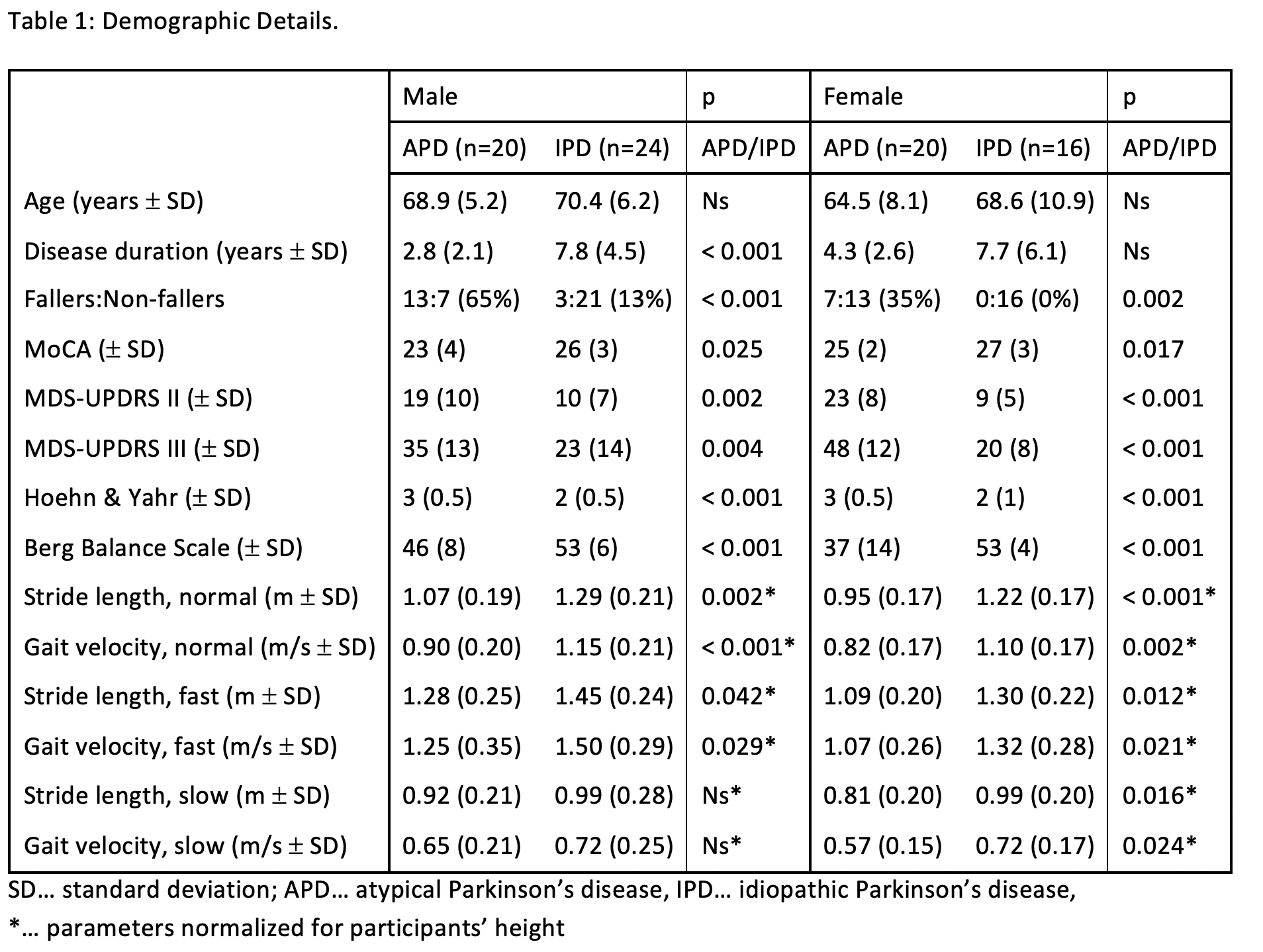Category: Parkinsonism, Atypical: MSA
Objective: The aim of this study was to further assess gender-specific gait and balance differences related to fall frequency in APD and IPD patients.
Background: Several papers highlight the increased risk of falls in idiopathic Parkinson’s disease (IPD) compared to healthy controls with mainly reduced stride length and gait velocity. Our knowledge on gender-specific gait patterns in IPD is limited, and these aspects have never been assessed in patients with atypical parkinsonism (APD).
Method: Patients were recruited as part of the multicentric, international Mobility_APP trial (NCT04608604). Participants underwent motor rating (MDS-UPDRS III, Hoehn & Yahr), as well as cognitive (MoCA) and balance (Berg Balance Scale, BBS) assessment. Every patient underwent a standardized sensor-based gait analysis of 20 meters for stride length (SL) and gait velocity (GV) in self-preferred normal, fast and slow speed. Patients were considered as fallers, if they had more than one fall within the last year.
Results: Demographical details are presented in table 1. We included 40 male and 36 female patients into this analysis. Women had higher MDS-UPDRS III scores (p=0.005) and a more impaired balance (p=0.031) compared to men. Overall, 29% of participants were defined as fallers. Falls in male patients had a strong correlation with disease severity (Hoehn & Yahr r2=0.637 & MDS-UPDRS III r=0.544) and BBS (r2=0.500), and moderate correlation with cognition (MoCA; r2=0.325) and self-preferred GV (r2=0.341). Female patients’ fall risk strongly correlates with balance (r2=0.483) and moderately correlates with disease severity (MDS-UPDRS III r2=0.310) and SL in normal (r2=0.462) fast (r2=0.437) and slow (r2=0.419) gait velocity.
In male patients, SL and GV in normal and fast speed were significantly lower in APD compared to IPD. Same applies for female participants but here, differences can also be seen in slow speed (see table 1). Regression analysis revealed that male gender was associated with a 11-fold increased risk of falling in our cohort. Other fall predictors included diagnosis of an APD and a lower balance score.
Conclusion: Although literature does not give much evidence on gender-specific differences of gait and falls in parkinsonian syndromes, this data show a higher frequency of falls in male APD patients even with lower motor impairment, shorter disease duration and better balance. The underlying mechanisms are still unclear and have to be further evaluated.
To cite this abstract in AMA style:
V. Sidoroff, F. Jagusch, P. Bachmann, N. Roth, N. Hergenröder-Lenzner, I. Teckenburg, A. Ibrahim, S. Büchner, D. Benninger, K. Seppi, F. Krismer, B. Eskofier, J. Winkler, J. Klucken, K. Aminian, H. Gassner, G. Wenning, C. Raccagni. Gender-specific differences of gait in parkinsonian syndromes [abstract]. Mov Disord. 2023; 38 (suppl 1). https://www.mdsabstracts.org/abstract/gender-specific-differences-of-gait-in-parkinsonian-syndromes/. Accessed December 18, 2025.« Back to 2023 International Congress
MDS Abstracts - https://www.mdsabstracts.org/abstract/gender-specific-differences-of-gait-in-parkinsonian-syndromes/

